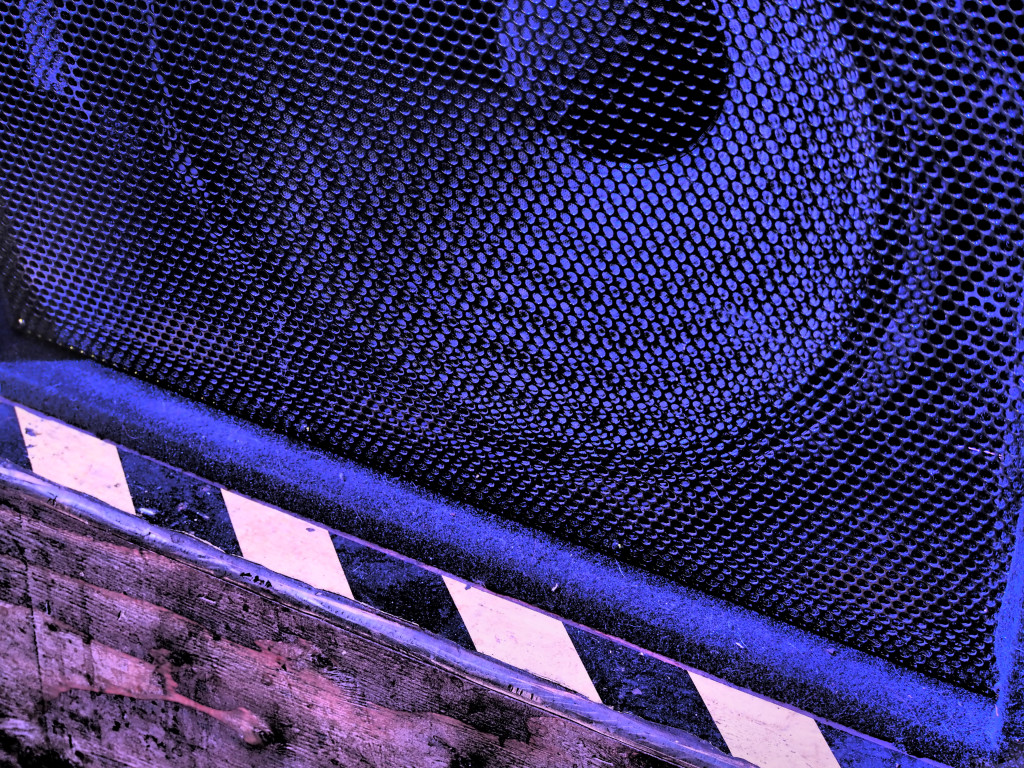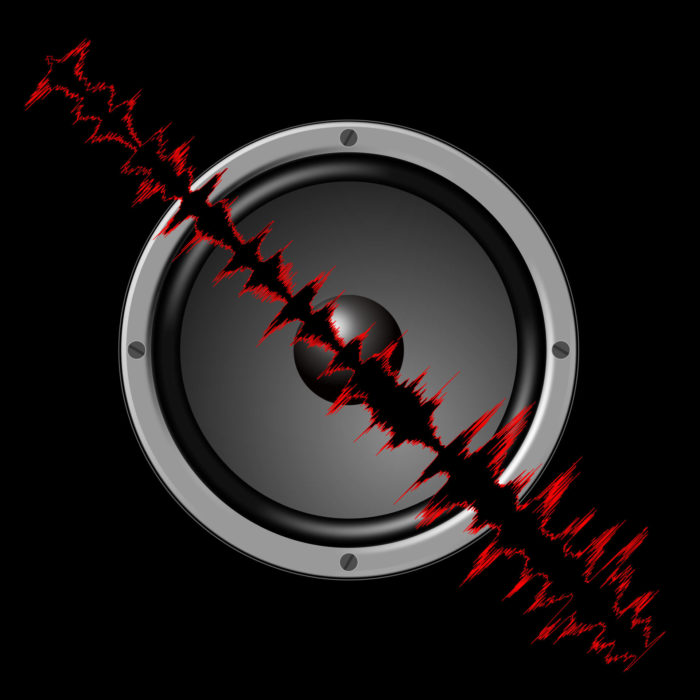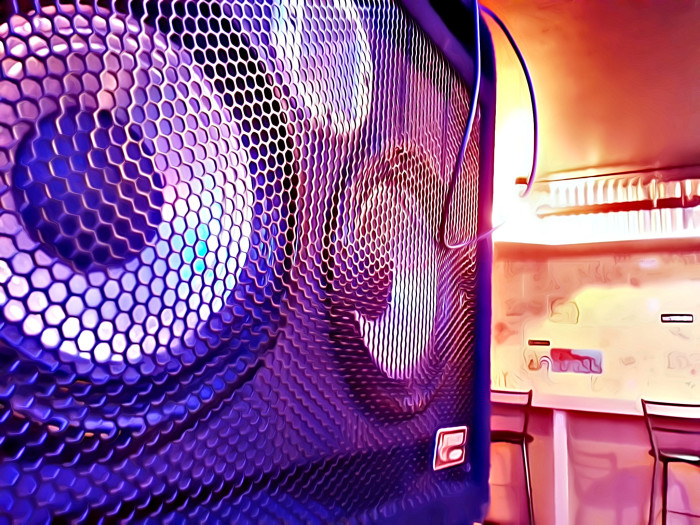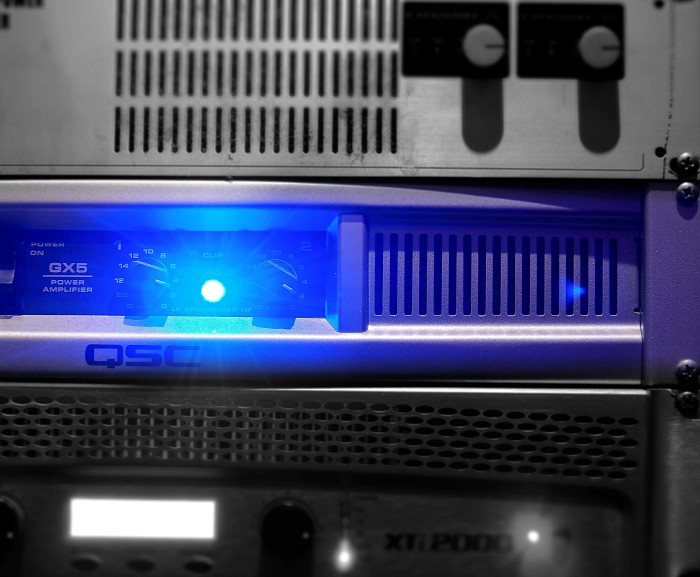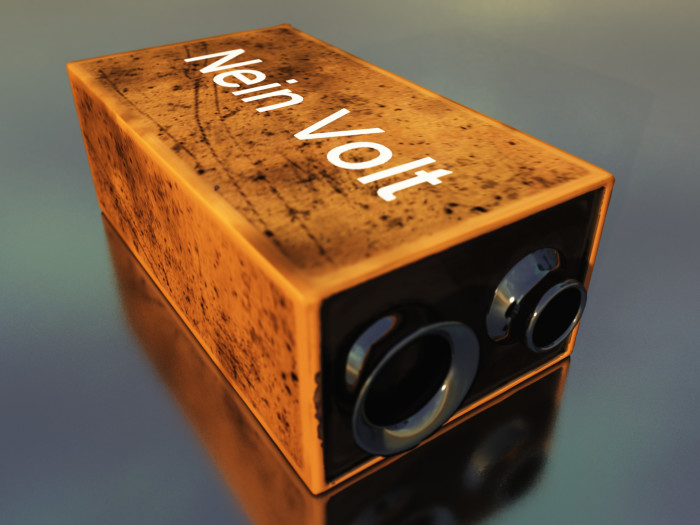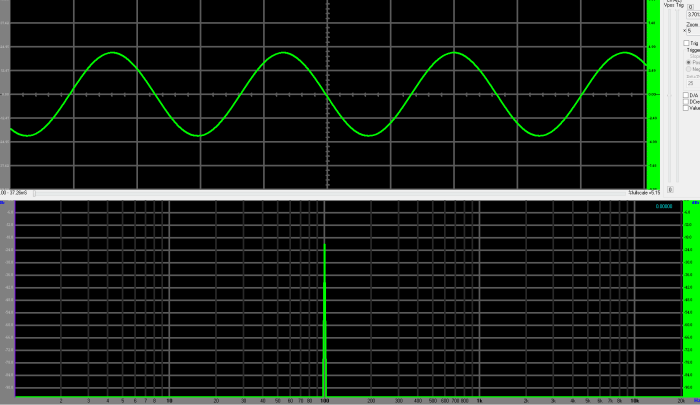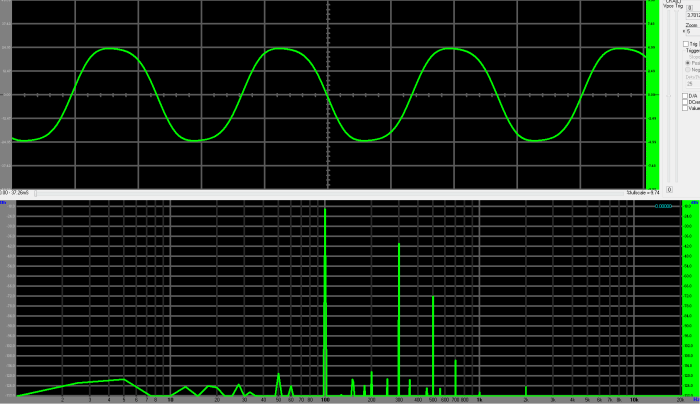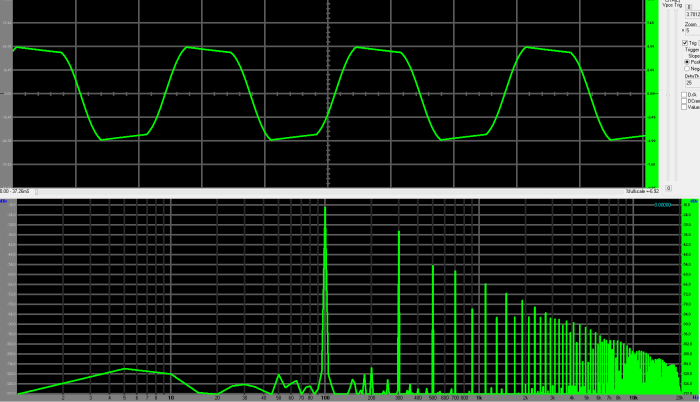For people who buy passive speakers (loudspeakers driven by amplifiers in separate enclosures), the question of how much amp to purchase is somewhat sticky. Ask it, and you’ll get all manner of advice. Some of it good, some of it bad, and some of it downright ludicrous. You’re very likely to hear a bunch of hoo-ha about how using too small of an amp is dangerous (it isn’t), because clipping kills drivers (it doesn’t). Someone will eventually say that huge amps give you more headroom (sorry, but no). All kinds of “multipliers” will be bandied about.
You may become more confused than when you started.
In my opinion, the basic answer is pretty simple, although the explanation will take a bit of time:
First, note that even though physicists will tell you that there’s no such thing as “RMS power,” there IS such a thing as the average or continuous power derived from a certain RMS voltage input. That’s what “RMS power” on a spec sheet means.
For a reasonable balance of safety and performance, match the amp’s continuous rating with the loudspeaker’s continuous rating.
(If you cannot find a loudspeaker’s continuous rating, clearly stated, on a spec sheet, take the smallest rating you can find and divide by two. If you cannot easily find an amp’s continuous rating on a spec sheet, just choose a different amplifier.)
For slightly more performance at the cost of some safety, choose an amplifier with a continuous rating that is half the peak power handling of the loudspeaker.
Depending upon how a loudspeaker is rated, the “safety” and “performance” criteria may actually end up giving you the same answer. This is perfectly acceptable.
Now then. Here’s how I justify my advice.
Peak / √2
The first step here is to understand a bit more about some basic bath and science regarding amplifiers.
A power amplifier is really a voltage amplifier that can deliver enough current to drive a loudspeaker motor. A power amplifier has an upper limit to how much voltage it can develop, as you might expect. That maximum voltage, combined with the connected load and the amplifier’s ability to supply current, determines the amplifier’s peak power.
In normative cases, an amplifier’s peak output is an “instantaneous” event. If the amplifier is contributing no noticeable distortion to the signal, then the signal “swing” is reaching the amplifier’s maximum voltage for a very small amount of time. (Ideally, an infinitely small duration.) Again, if we assume normal operation, an amplifier spends the overwhelming majority of its life producing less than maximum output.
An amplifier’s continuous power, on the other hand, is an average over a significant amount of time. This is why engineers say things like “power is the area under the curve.” An undistorted peak with nothing before or after it has virtually no area under the curve, whereas a signal that never gets anywhere near peak output (but lasts for several seconds) can have very significant area under the curve.
For audio voltages, we use RMS averaging. One important reason for this is because audio voltages corresponding to sound-pressure events have positive and negative swing. For, say, one cycle of a sine wave, the arithmetic mean would be zero – the wave has equal positive and negative value. RMS averaging, on the other hand, squares each input value. As such, positive values remain positive, and negative values become positive (-2 squared, for instance, is 4).
In the case of an undistorted sine wave, the RMS voltage is the peak voltage divided by √2, or about 1.414.
Here’s a graph to make this all easier to visualize. This is a plot of a very small, hypothetical power amplifier passing an undistorted sine wave. The maximum output voltage is ± 2 volts. That means that the RMS voltage is 2/√2, or 1.414.
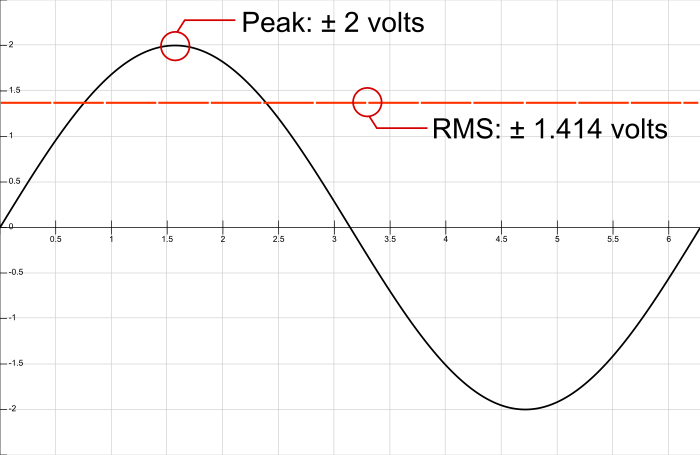
Here’s where the rubber begins to meet the road. Let’s assume that this amplifier is mated to a loudspeaker with an impedance of 8 Ohms.
Power = Voltage Squared / Resistance
Peak Power = Peak Voltage Squared / Resistance
Continuous Power = RMS Voltage Squared / Resistance
Peak Power = 2^2 / 8 = 0.5 Watts
Continuous Power = (2 / √2)^2 / 8 = 0.25 watts
For a sine wave, the continuous power is half the peak power, or 3 dB down. This is the main justification for the above statement: “For slightly more performance at the cost of some safety, choose an amplifier with a continuous rating that is half the peak power handling of the loudspeaker.” Assuming that the amplifier was rated using sine-wave input (a reasonable assumption at the time of this writing), the peak output of the amplifier will be twice the continuous rating, and therefore match up with the peak power handling of the loudspeaker. By the same token, the “safety” recommendation means that the peak amp output will be either at or far below the peak rating of the loudspeaker – especially since many loudspeakers are claimed to handle peaks that are four times greater than the recommended continuous input.
An amplifier with peak output capabilities that exceeds the peak handling capabilities of a loudspeaker is a liability, not an asset. In live-sound, all kinds of mishaps can occur which will drive an amp all the way to its maximum output. If that maximum output is too high, you might just have an expensive repair on your hands. If the maximum amplifier output plays nicely with the loudspeaker’s capabilities, however, accidents are much less worrisome.
So, there’s the explanation in terms of peak power. What about some other angles?
A More Holistic Picture
Musical signals running through a PA are usually not pure sine waves. They can be decomposed into pure tones, certainly, but the total signal behavior is not “RMS voltage = peak / √2.” You might have an overall continuous power level that’s 10 dB, 12 dB, 15 dB, or even farther down from the peaks. Why could you still run into problems?
The short answer is that not all drivers are created equally, and EQ can make them even more unequal. Further, EQ can cause you to be rather more unkind than you might realize.
For a bit more detail, let’s make up a compromise example using pink noise that has a crest factor of slightly more than 13 decibels. If we run the signal full-range, we get statistics that look like this:

Let’s say that we have a QSC GX5 plugged into an 8 Ohm loudspeaker. A GX5 is rated for 500 watts continuous into that load, so a reasonable guess at peak output is 1000 watts. To find -13 dB in terms of power:
10 log (x / 1000) = -13 dB
log (x / 1000) = -1.3 dB
10^-1.3 = 0.0501 = x / 1000
x = 50 watts
(Of course, -13 dB can also be found by dividing -10 dB, or 0.1 X power, by two.)
That power hits a passive crossover, which splits the full range signal into appropriate passbands for the various drivers. In an affordable, two-way box, the crossover might be something like 12 dB / octave at 2000 Hz. If I filter the noise accordingly, I get this for what the LF driver “sees”:

Compared to the original peak, the LF driver is seeing about -14.5 dB continuous, or a bit more than 35 watts. Some instantaneous levels of about 800 watts come through, but the driver can probably soak those up if most of the energy is above, say, 40 Hz.
For the HF driver:

Again, we have to compare things to the original peak of -0.89 dB, so the continuous measurement is actually 17.8 dB down from there. Also, an additional complication exists. The HF driver is probably padded down at the crossover, because a compression driver mated to a horn can have a sensitivity of 104+ dB @ 1 watt @ 1 meter, whereas the cone driver might be only 96 dB or so. In the case of an 8 dB pad, the total continuous power being experienced by the HF portion of the box could reasonably be said to be -25.8 dB from the peak power. That’s something like 2.5 watts, with peaks at 37 watts or so.
No problem, right?
But what if you bought a really powerful amp – like one that could deliver peaks of 2000 watts?
Your HF driver would still be okay, but your LF driver might not be. Sure, 70 watts continuous wouldn’t burn up the voice coil, but what would 1600 watt peaks do? Especially if the information is “down deep,” that poor cone is likely to get ripped apart. If somebody does something like dropping a mic…well…
And what if someone applies the dreaded “smiley face” EQ, and then drives the amp right up to the clip lights?
At first, things still look OK. The continuous signal is still 13 dB down from the peaks.

The LF driver is getting something like this:

For the reasonably-sized amp, the LF peaks are at 0.7 dB below clipping, or 850 watts. That’s probably a little too much for the driver, but it might not die immediately – unless a huge impulse under 40 Hz comes through. With the oversized amplifier, you now have 1700 watt peaks, which are beating up your LF cone just that much faster.
In the world of the HF driver:

Using the appropriate amp, the HF driver isn’t getting cooked at all. In fact, the abundance of LF content actually pushes the continuous and peak power down slightly. Even the big amp isn’t an issue.
Of course, someone could decide to only crank the highs, because they want “that crispness, you know?” (This would also correspond to program material that’s heavily biased towards HF information.)

Now things get a little scary. Scale the measurement right up to clipping (0 dB, because this reading was taken “in isolation”), and the peaks are padded down to only -8 dB. That’s almost 160 watts, which is beyond the peak tolerance of the driver. The 13 watts of continuous input isn’t hurting anything, but the poor little HF unit is taking plenty of abuse.
Connect the “more headroom, dude!” amplifier, and it gets much worse. One 320 watt peak will surely be enough to end the life of the unit, and if (by some miracle) the peaks are limited but the continuous power isn’t…well, the driver might withstand 26 watts continuous, but just two more dB and you get 41 watts. The poor baby is probably roasting, if it’s an affordable unit.
Conclusions
I’m sorry if all that caused your eyes to glaze over. Here’s how it shakes out:
An amp which has a continuous rating that matches the loudspeaker’s continuous rating does a lot to protect you from abuse, accidents, and stupidity. Using an amplifier that has a peak rating equal to the speaker’s peak rating lets you get a bit more level (3 dB) while still shielding you from a lot of problems. You can still get yourself into trouble, but it takes some effort.
Running an amplifier which goes a long way past the peak rating of a speaker enclosure is just asking for something to get wrecked. Yes, you can make it all work if you’re careful and use well-set processing to keep things sane – but that’s beyond the scope of this article.
If a conservatively powered PA doesn’t get loud enough for you, you need more PA. That is, you need more boxes powered at the same per-box level, or boxes that are naturally louder, or boxes that will take more power.

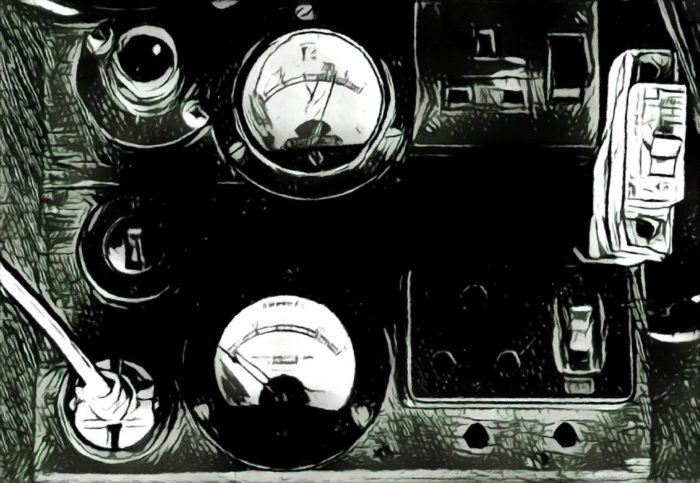 Want to use this image for something else? Great! Click it for the link to a high-res or resolution-independent version.
Want to use this image for something else? Great! Click it for the link to a high-res or resolution-independent version.